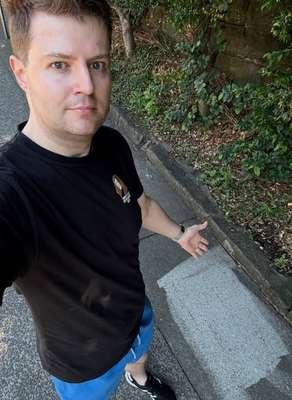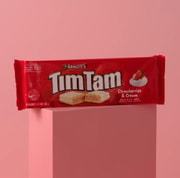Council members argue over 'cheeky' campaign advert on public spaces
By
Danielle F.
- Replies 26
As the countdown to the upcoming federal election ticks away, the political landscape is heating up in the halls of power.
Yet, the tension has been felt and seen on the streets.
In one of Australia's well-heeled suburbs, a unique form of political advertising sparked a divisive and fiery debate.
Woollahra's Deputy Mayor, Councillor Sean Carmichael, publicly criticised a local federal member over her unique approach to getting the word out.
Instead of the usual flyers and posters, independent MP Allegra Spender has been using high-grade pressure and stencil hoses for her advertisements.
Her canvas? Grimy local footpaths.
Councillor Carmichael took to social media to express his disapproval of Spender's advert tactics.
'This is council property that has been defaced with what is clearly, in substance, graffiti,' Councillor Carmichael argued.
He also added that the act could breach Australian Electoral Commission rules due to the lack of authorisation.
The council deployed workers to remove the 'nine acts of reverse graffiti' Spender and her team made on the footpaths—a 'difficult' task without industrial-grade machinery.
'These defaced concrete footpaths are otherwise in satisfactory condition,' Councillor Carmichael added.
'The implied argument they are dirty and needing cleaning is—in my own view—incredibly cheeky and does not pass.'
In contrast, Spender's campaign defended the tactic and questioned the council's use of local ratepayers' money to remove the messages.
'The messages are created with water pressure that actually cleans the dirt off the footpath,' a campaign spokesperson stated.
'It's disappointing that the Liberal Party-controlled council is misusing ratepayers' money to remove a political opponent's messages.'
'The messages are temporary and fade away naturally,' the spokesperson concluded.
The debate over Ms Spender's 'reverse graffiti' tactic came at a time when political engagement was at an all-time high.
The Australian Electoral Commission reported a record number of people enrolled to vote on Saturday, 3 May.
Nearly 18.1 million Australians, including seniors, are ready to cast their ballots.
Here are several reminders voters, especially seniors, need to keep in mind.
Ms Spender's unique use of pressure washers and stencils was a novel approach to political campaigning.
However, many also raised questions about the use of public spaces for political expression.
As Australia gears up for the election, the debate over such tactics may continue for the next few weeks.
The 'reverse graffiti' controversy was just one example of how the battle for votes could extend beyond policy debates and into public spaces and communities.

So, what do you think about MP Spender's unique campaign adverts? Have you seen other creative or controversial campaign tactics in your area lately? Share your thoughts and stories with us in the comments section below.
Yet, the tension has been felt and seen on the streets.
In one of Australia's well-heeled suburbs, a unique form of political advertising sparked a divisive and fiery debate.
Woollahra's Deputy Mayor, Councillor Sean Carmichael, publicly criticised a local federal member over her unique approach to getting the word out.
Instead of the usual flyers and posters, independent MP Allegra Spender has been using high-grade pressure and stencil hoses for her advertisements.
Her canvas? Grimy local footpaths.
Councillor Carmichael took to social media to express his disapproval of Spender's advert tactics.
'This is council property that has been defaced with what is clearly, in substance, graffiti,' Councillor Carmichael argued.
He also added that the act could breach Australian Electoral Commission rules due to the lack of authorisation.
The council deployed workers to remove the 'nine acts of reverse graffiti' Spender and her team made on the footpaths—a 'difficult' task without industrial-grade machinery.
'These defaced concrete footpaths are otherwise in satisfactory condition,' Councillor Carmichael added.
'The implied argument they are dirty and needing cleaning is—in my own view—incredibly cheeky and does not pass.'
In contrast, Spender's campaign defended the tactic and questioned the council's use of local ratepayers' money to remove the messages.
'The messages are created with water pressure that actually cleans the dirt off the footpath,' a campaign spokesperson stated.
'It's disappointing that the Liberal Party-controlled council is misusing ratepayers' money to remove a political opponent's messages.'
'The messages are temporary and fade away naturally,' the spokesperson concluded.
The debate over Ms Spender's 'reverse graffiti' tactic came at a time when political engagement was at an all-time high.
The Australian Electoral Commission reported a record number of people enrolled to vote on Saturday, 3 May.
Nearly 18.1 million Australians, including seniors, are ready to cast their ballots.
Here are several reminders voters, especially seniors, need to keep in mind.
Ms Spender's unique use of pressure washers and stencils was a novel approach to political campaigning.
However, many also raised questions about the use of public spaces for political expression.
As Australia gears up for the election, the debate over such tactics may continue for the next few weeks.
The 'reverse graffiti' controversy was just one example of how the battle for votes could extend beyond policy debates and into public spaces and communities.
Key Takeaways
- Woollahra's Deputy Mayor Sean Carmichael criticised independent MP Allegra Spender for 'reverse graffiti' advertising on footpaths.
- The advertising technique involved using a high-pressure hose and stencils to create clean messages on dirty footpaths.
- The Deputy Mayor claimed that the removal of the messages was costly and difficult without industrial-grade machinery.
- MP Spender's camp stated that the stencils could effectively clean footpaths due to pressure washing.









